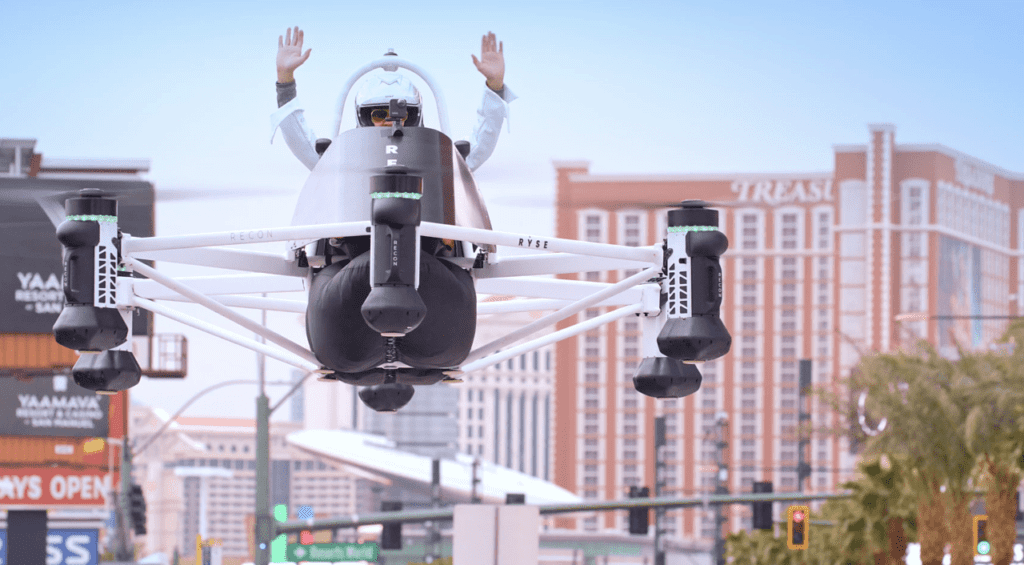
RYSE flew its RECON eVTOL aircraft during the Consumer Electronics Show in Vegas. The company also recently announced that it has opened the reservation system for the ultralight vehicle. (Photo: RYSE)
RYSE Aero Technologies recently announced the opening of the reservation system for their ultralight eVTOL [electric vertical take-off and landing] vehicle, the RECON. The eVTOL aircraft are expected to be delivered in the fourth quarter of this year. Customers are able to reserve the RECON for purchase at ryseaerotech.com. RYSE’s aircraft was also the first eVTOL to take flight at the recent Consumer Electronics Show in Las Vegas.
RYSE started conducting manned test flights of its RECON aircraft last summer, with the first manned flight taking place on June 27. It’s designed to be very simple to operate, and it can be flown under Part 103, while other major eVTOL developers are pursuing airworthiness certification within Part 135.
In an interview with Avionics International, CEO Mick Kowitz shared insights into the company’s plans for the upcoming year and beyond. Check out our Q&A below.
Avionics: Can you share details about RYSE’s debut at CES?
Mick Kowitz: We were granted privilege by the Las Vegas Metro Police Department, the Clark County Sheriff, the Clark County Film Bureau, and the FAA to actually fly in downtown Las Vegas. We flew down the Las Vegas Strip during CES, and we actually shot a video—we had a little fun with it. Our Elvis impersonator landed it after flying down the strip, then walked towards the Las Vegas Convention Center as kind of a teaser for the show.

“Right now while we’re targeting large farmers, we’ll be looking beyond that into government, parks services, and into other industries.” (Photo: RYSE)
We were the first company to get to fly live at CES—no one’s ever been allowed to fly. During the show, we flew every hour. That’s a huge milestone, to do that at the Consumer Electronics Show. As part of that, we also launched the reservation system. We had a QR code in the booth and allowed people to get on the waitlist. They put in their property information, what kind of property, what their use case is, and any additional information. Based on that information, they’re getting a spot in line to be able to reserve a RECON.
How many reservations have you received so far?
Kowitz: We probably have close to $10 million worth of reservations already in line [from roughly 75 to 100 customers]. We’re really excited about that.
At the Consumer Electronics Show, you get consumers, which aren’t necessarily our actual target market. We’re really going after people who’ve got a lot of land, the farming community, the ranching community. We’re now just doing a lot of press, trying to get the word out to make everybody aware that the reservation system is now available.
We expect the reservation to continue at a high volume, and really within a very short order, we were already up to about $7 or $8 million worth of reservations. That’s almost our first-year order book, because we’re going to build 100 our first year. So having 100 already teed up after less than a month is pretty amazing.

The RECON has six independent propulsion systems with rechargeable batteries. (Photo: RYSE)
How is the team progressing towards the goal of rolling out the vehicle in the fourth quarter of 2023?
Kowitz: I think the challenges are really limited, because it’s a pretty simple build. [As far as] the manufacturing, we have the facility and it’s coming along very nicely. We are still in pre-production, so we’re building vehicles by hand right now. Those are going out to choice farmers and ranchers to play with, so that by the time we’re ready to move into full-blown manufacturing, in the late third quarter, we’ll be ready to deliver a vehicle that is durable and has stood the test of use cases like farming and ranching.
The manufacturing facility is pretty straightforward for us because we’re packaging up [the vehicle] and the assembly will be done at the farm or through a distributor. We’re shipping the vehicle without the seat, without the pods or propellers on it, and the distributor will put it together. It’s really pretty straightforward to do even if you’re not mechanically inclined. The training will be the big thing—we’ll do the training through the distributors, or our team will do the training with the person flying it. For the first 100, we’re going to do a lot of the training. We have a couple of distributors teed up in a couple of key states. We’ll be announcing those fairly soon.

RYSE designed its aircraft with a rugged structure that makes it ideal for agricultural applications and operating in difficult-to-reach areas. (Photo: RYSE)
What are some of your mid- to long-term goals over the next few years? How do you envision the company growing?
Kowitz: There’s two ways you can go with this. One is to attract other buyers by building another vehicle; that is certainly something we’re looking at. But really, our goal is to build markets. Right now while we’re targeting large farmers, we’ll be looking beyond that into government, parks services, and into other industries like mining or energy.
The agricultural market is an $84-billion-a-year large farm equipment market. So there’s plenty of market share, and plenty of people who are probably going to want this vehicle just in the ag community. But we do see it expanding into other areas—municipalities, local government, state government, federal government—we think that’s a legitimate opportunity for us. Other vehicles are definitely something we want to look at, but we’re not really talking about what those designs are at this point.